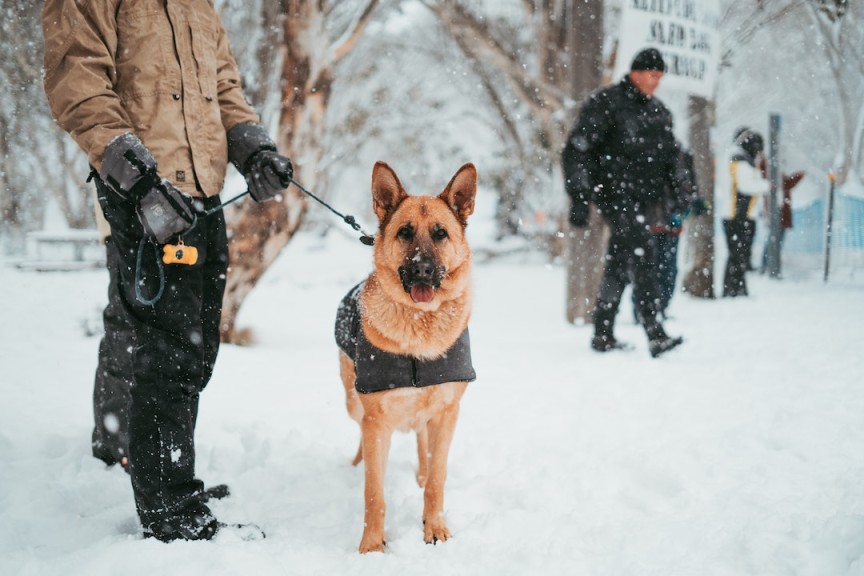How to Treat Your Dogs Arthritis in Winter
Posted: 01/02/2023 | BY: Erin Cain | Categories: Dog , Health problems , Pet care , Pre-Existing conditions
When your dog wakes up in the morning, are they a bit slower to move? Do they seem sore? Do they walk down the stairs more carefully, or is there less bounce in their step as you head outside for their daily walk? If so, your pooch may be exhibiting signs of arthritis, a common inflammation of the joints that affects middle-aged and senior dogs and certain dog breeds. Unfortunately, arthritis can be a painful condition for your pup, made even more difficult when winter arrives, and temperatures drop. Keep reading for practical ways to treat your dogs’ arthritis in winter.

What is arthritis in dogs?
Arthritis is an inflammation of the joints that is typically a natural, age-related condition. This chronic and progressive disease can occur in different forms, primarily:
- Primary osteoarthritis, or degenerative joint disease (DJD), is the most common type in dogs and people, where the wear-and-tear of cartilage in the joints results in inflammation and pain;
- Secondary osteoarthritis, common particularly to canines, is connected with congenital conditions or injuries where a joint injury or misalignment has caused the premature wearing down of cartilage in joints; dogs with hip or elbow dysplasia often display this type of arthritis.
Regardless of the source, the stiff joints, discomfort, and pain related to arthritis could have a profound impact on your dog’s activity level, overall personality and quality of life.
What are the signs of arthritis in dogs?
Arthritis can affect dogs of any age or breed, but may manifest itself in different ways among these groups. Generally, the main signs of arthritis in dogs are:
- Slowness to get up from a sitting or lying position
- Reluctance to walk up or down stairs
- Hesitation to play or exercise
- Limping or hopping
- Lameness
- Vocalization (in advanced cases)
- Changes in personality (in advanced cases)
Every dog is individual and may therefore react to arthritic pain and discomfort differently. Some dogs will go off on their own, while others will become more clingy and demanding of your attention. So take notice of any changes in your dog’s behavior and speak with your veterinarian about whether arthritis may be the cause.
Why does cold weather make arthritis worse?
Arthritis is tough on any pup, but what is it about winter that makes this condition worse? There are a few possible reasons for increased arthritic stiffness and pain when the temperatures fall.
First, the drop in atmospheric air pressure causes pain in joints. Then when the pressure decreases, tissues swell and become inflamed. The result is increased tension between the joints, which means more pain.
Another potential reason for higher levels of arthritic pain is that cold temperatures cause pain receptors to become more sensitized. This condition magnifies the pain your dog feels typically in her joints.
Muscles around the joints tend to stiffen in the cold, which also makes them more susceptible to spasms. Both of these factors lead to more pain and stiffness in the joints.
Finally, pet parents are less likely to spend time outside in cold weather, which means their dogs get less time outdoors. Joint pain can be alleviated when arthritic dogs are on the move, warming up their muscles and combatting joint stiffness. An inactive pup may also put on extra pounds over the winter, and heavier weight will only make the pressure on the joints and joint pain worse.

How to treat your dogs’ arthritis in winter
There are a variety of steps that you can take to lessen your dog’s arthritic pain when temperatures grow colder. Consider adding these steps to a winter treatment plan for your pup:
1. Exercise, exercise, exercise. Despite the cold weather, make a point to walk your dog at least once, and preferably twice, daily. Moving and stretching those muscles will make your dog feel better, make those muscles stronger, and relieve stiffness in the joints. In extreme weather conditions, work to keep your dog moving inside your home with fun games and training exercises. Consider indoor doggie classes or physical or hydrotherapy opportunities to keep your pup moving during the winter months.
2. Joint supplements and non-steroidal, natural anti-inflammatory supplements are proven methods that may ease your dogs’ discomfort and pain. Look for supplements that support cartilage production and protect existing cartilage from wearing down, especially those that include glucosamine, chondroitin, MSM, and omega-3 fatty acids. Speak with your veterinarian about which supplement is right for your dog or whether your dog would respond better to pain medications.
3. Maintain a healthy weight for your dog, depending upon their age, stature, and current health status. If your dog is already overweight, design a safe weight loss program with your veterinarian. Extra weight puts more pressure on the muscles and joints, so maintenance or weight reduction if needed, are ways to keep your pet moving with less pain.

4. Heated beds and blankets can ease your dog’s muscles and joints, making it a bit easier for your dog to move and stand up on a cold morning. There are many self-reflected heating beds or ones that contain removable heaters explicitly designed to support aging, arthritic dogs.
5. For dogs with advanced arthritis, added assistance from a dog ramp, dog stairs, or a dog support sling or harness makes it less painful for your dog to get upstairs, get into bed, or hop into the car.
6. Consider alternative therapies, such as acupuncture, therapeutic massage, or physical therapy, that can aid your dog in the fight against arthritis. Your veterinarian will have recommendations for clinics and practitioners in these areas.
With these suggestions, you can put together a plan to keep your dog moving and as pain-free as possible this winter, no matter how cold it gets.
Take care of your arthritic dog this winter
No matter the season, arthritis has a significant impact on any dog’s quality of life. Winter tends to take a harder toll on arthritic canines, but you can make a difference for your pup. By carefully observing your dog, speaking with your veterinarian, and adopting the right approaches, you can ensure that your dog doesn’t suffer as much from arthritis this winter.
Protect them all year long
Whether your furry family member is old, young, or somewhere in between, you can protect them all year long from illness and injury with a pet insurance health policy. Whether or not your pup is suffering from arthritis or any other ailment, we know that any medical care (expected and unexpected) can incur vet bills into the hundreds or even thousands of dollars.
With all the pet insurance choices now available, there’s an affordable plan for every budget. Some with payments as low as $10 per month! And some that will pay up to 90% of your vet bills!
To learn more, visit Pet Insurance Review, where you’ll find thousands of reviews for 20+ of the top pet insurance providers, see side-by-side plan comparisons, and get a quote instantly! Start protecting your pup (and your wallet) today.
References:
- Marcellin-Little, D. (2020). Managing canine osteoarthritis in all stages and ages. Retrieved from https://www.veterinarypracticenews.com/osteoarthritis-june-2020/
- DVM360. (2015). Managing osteoarthritis in dogs (Proceedings). Retrieved from https://www.dvm360.com/view/managing-osteoarthritis-dogs-proceedings
- Morris Animal Foundation. (2020). Hip Dysplasia — Understanding a Common and Challenging Orthopedic Disease in Dogs. Retrieved from https://www.morrisanimalfoundation.org/article/hip-dysplasia-understanding-common-and-challenging-orthopedic-disease-dogs
- Hinds, N. (2020). 19 Tips to Get Your Dog Indoor Exercise in Winter. Retrieved from https://www.k9ofmine.com/dog-indoor-exercise-in-winter/
- College of Veterinary Medicine & Biomedical Services, Texas A&M University. (2018). Canine arthritis And Your Dog’s Best Defence — Weight Loss. Retrieved from https://moderndogmagazine.com/articles/canine-arthritis-and-your-dogs-best-defence-weight-loss/96695
Disclaimer
The information contained on this blog is intended for informational and educational purposes only and should not be construed as medical advice. It is not a substitute for professional veterinary care. Always consult with your veterinarian before making any changes to your pet's health care or treatment plan.
The authors of this blog are not veterinarians and do not claim to be experts in pet health. The information provided here is based on our own experiences and research, as well as information from reputable sources. However, we cannot guarantee the accuracy or completeness of this information.
We encourage you to do your own research and consult with your veterinarian before making any decisions about your pet's health.
Compare top pet insurance providers plans.
Enter your dog’s age in years and months to calculate their age equivalent to human years.
Calculate your dog’s ageEnter your cat’s age in years and months to calculate their age equivalent to human years.
Calculate your cat’s age